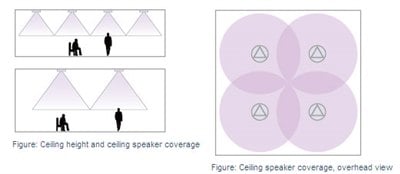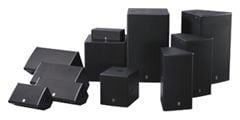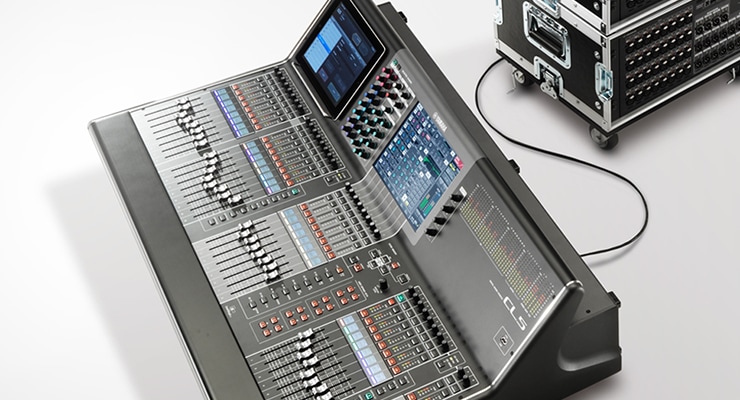Better Sound for Commercial Installations
Part 2: Amplifers and Speakers

02. Speaker Layout and Sound Pressure Level
The speaker layout for any space needs to be planned according to the size, shape, and intended use of the space in order to supply sufficient sound pressure level consistently throughout the listening area. Of course the performance of the speaker systems used is important, but positioning and layout are critical in achieving high-quality sound.
Positioning for Directional or Non-directional Sound
The first step when planning a speaker system is to decide whether or not listeners should be able to locate the source of the sound. That is, whether the speaker system is to be directional or non-directional.
Non-directional Installation (Distributed Sound)
In this case speakers are positioned throughout the listening area so as to achieve equal sound pressure level at every listening position. Such installations are appropriately known as "distributed speaker systems." Distributed systems are designed with emphasis on ensuring that the same volume and sound quality are maintained throughout the listening space, rather than on achieving directionality. Distributed systems are mostly used for broadcasting announcements and background music.
Directional Installation
In this type of installation the speakers will all be facing in about the same direction, and may even be clustered together in one part of the space. Listeners will clearly hear that the sound is coming from a specific direction. This type of positioning is appropriate for live events and other situations in which directionality is important, and where the listeners will be seated or remain in a limited area.
Some installations combine both of the methods described above. In a directional system where the primary speakers are not able to provide sufficient sound pressure level or intelligibility throughout the entire space, for example, supplementary speakers may be positioned to "fill in the gaps." Supplementary speakers are often required in very large or reverberant spaces to uniformly fill the entire space with sound while maintaining a sense of directionality.
The Main Guideline for Speaker Layout is SPL

Once the type of layout has been decided then next step is to choose the type and number of speaker systems to be used. The most important criterion for these decisions is sound pressure level. It goes without saying that the main purpose of a sound system is to deliver sound to the listeners, and it must be able to do so over any ambient noise. It is therefore necessary to measure the ambient noise under a variety of conditions, such as customer traffic and time of day, and design the sound system so that it can consistently deliver sound pressure levels that are higher than the ambient noise levels by a specified amount. For general announcements the sound system must be able to deliver sound pressure levels that are 6dB higher than the ambient noise, and for BGM the SPL should be at least 3dB higher than the noise.
Armed with that information we'll take a look at the average background noise levels and required sound system sound pressure levels for a variety of facility types.
Now that we know approximately what sound pressure level we need, how do we determine how many speaker systems we'll need to deploy in order to achieve that level? Here's where we actually need the specialized knowledge of a professional to come up with accurate data, but below we'll summarize the basic approach for distributed speaker installations using surface mount and ceiling speakers.
Surface Mount Distributed Installation
The number of speaker systems to be used must be determined such that consistent sound pressure level is achieved throughout the listening area. For wall mounting, the mounting hardware is chosen to allow installation at the optimum height with appropriate angle adjustment capability. Even within the coverage area of a single speaker system the level will fall off over distance, so there will be a difference between the SPL at the closest and furthest listening points. It is important to ensure that the levels will not be too high or low at those points. We'll take a closer look at attenuation over distance later on.
Ceiling Speaker Distributed Installation

As you can see in the diagram, a lower ceiling - i.e. a shorter distance between ceiling speakers and the listening point - results in a smaller the coverage area for each speaker. Lower ceilings therefore require a greater number of speakers for uniform coverage. It is more effective to use surface mount speakers where the ceiling is low in some cases. But ceiling height isn't the only factor that affects coverage. The height of the listening point - whether the listener is standing or sitting - must also be taken into account. And of course if the ceiling is high, the coverage of each speaker is greater but higher output level will be required to provide sufficient SPL at the listening point. Taking all of these elements into consideration, the number and layout of ceiling speakers must be specified to provide sufficient sound pressure level throughout the listening area.
Distance Attenuation in Directional Systems

The sound pressure level calculations for directional systems in which the speakers are all facing in the same direction and/or clustered together are quite different from systems designed for announcements or BGM. A maximum SPL of 100dB is generally considered to be a reasonable goal for high-quality sound in such systems. But just achieving an SPL of 100dB at the front row is not enough. The level of the sound leaving the speakers decreases over distance. Specifically, sound level decreases by the square of the distance under "standard" conditions, ignoring the effect of reflections. This means that for every doubling of distance the SPL will be attenuated by approximately 6dB.
Referring to the chart we can see that even though the SPL in the front row seats, 1 meter from the speakers, is 100dB, attenuation at a distance of 32 meters is 30dB, leaving us with an SPL of only 70dB. We could design the system to deliver 130dB to make up the difference, but while that would indeed give us an SPL of 100dB at 32 meters, listeners in the front would be bombarded with an unbearably high 130dB level. As we learned in "Part 1 - Sound Basics," the maximum sound level that the average person can withstand is around 120dB, so 130dB is simply too high for comfort, and can even cause hearing damage.
This attenuation of sound over distance must always be taken into account when designing a directional sound system, and supplementary speaker system included in the design as required.
Selecting Speaker Systems for Multi-Speaker Installations

The two most important considerations for combining multiple speaker systems in a large space are sound character and phase.
Consistent Sound Character
Since different types of speaker systems often sound different, when they are used together in a single space there is likely to be differences in sound character between the coverage areas of each type.
Phase Interference
When the same audio signal is output by two different speaker systems or speaker units, phase interference can be a problem. For example, if there is a difference in distance from the listening point between two different speaker systems delivering the same signal, phase interference will occur and certain frequencies may attenuated or cancelled out while others are unnaturally boosted. This problem can be particularly severe between speaker systems that have significantly different phase characteristics. The same problem can occur between speaker units in the same enclosure. In a 2-way system, for example, there is a certain amount of overlap between the frequency ranges handled by the high-frequency and low-frequency units. Phase interference in this overlapping region, at the system's "crossover point," can result in unnatural sound.
In addition to the problems of sound character and phase interference, the sound professional must take the acoustic characteristics of the space and a variety of other factors into account when installing and tuning a sound system. But before any of that can begin the sound pro must make informed equipment choices based on a thorough understanding of all of the above acoustic characteristics.
Yamaha's Installation Series speaker systems for small to medium installations, for example, have been carefully designed so that consistent sound character is achieved throughout the entire, comprehensive lineup. Even more importantly, uniform phase characteristics have been achieved throughout the lineup as well. This means that different speaker systems from the Installation Series can be combined to deliver outstanding sound quality with minimal installation and tuning effort.
Output Sound Pressure Level Indicates Speaker Efficiency

You'll almost always see the sound pressure level or "SPL" of a speaker system listed in its specifications. In this case SPL is used to indicate the efficiency of the speaker system.
The specified output sound pressure level of a speaker system is the sound pressure level measured at a distance of 1 meter with a 1-watt audio signal applied to the speaker system's input. Since the output of the power amplifier is always 1 watt for this measurement, the measured SPL at one meter indicates how efficiently that particular speaker system converts the electrical input into acoustic output. The higher the SPL value, the higher the efficiency of the speaker system. The chart shows how increases in power amplifier output relate to speaker output. Basically, in order to produce a 3dB increase in sound pressure level from the speaker, the power output of the amplifier must be doubled.
If you compare the specified output sound pressure levels of a number of speakers you'll notice that the difference in the numbers is quite small. But if you consider that amplifier output must be doubled to produce a 3dB increase in speaker output SPL, it becomes clear that the actual difference is significant.
For example, if speaker system "A" has a specified output SPL of 99dB while speaker system "B" has an output SPL of 96dB, speaker system "A" will deliver the same sound pressure level as speaker system "B" with only half the power! Speaker system "A "is much more efficient. If you consider your electricity bill and other long-term operating costs, speaker system "A" may be the more economical choice. Of course the performance of a speaker system cannot be determined on the basis of SPL specifications alone, but it is an important consideration.
The preceding two sections have dealt with the basic factors that influence speaker system selection. Once the speaker systems to be used have been chosen, it's time to think about power amplifiers. Power amplifiers can only be considered in relation to the speaker systems used. We'll look at some amplifier-to-speaker connection configurations in the following section.
Contents
The sound systems that broadcast the information you're hearing have been carefully designed and installed to suit the needs of each individual facility.
This series offers information aimed at achieving the best possible sound in commercial installations, from the basics to equipment selection and day-to-day operation.








